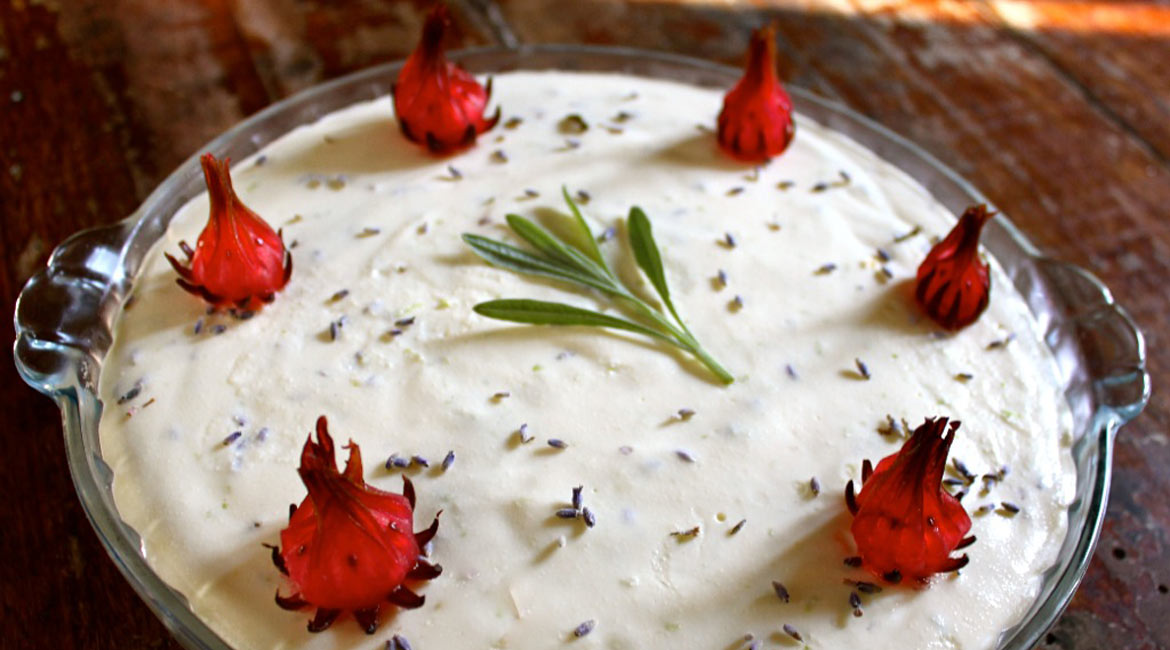
I could stare at a rosella plant in the same way our Jack Russell stares into the branches of a mukwa tree after spotting a squirrel. For hours and hours. It’s my kind of Bush TV, a descriptor mainly used when you are mesmerized by a campfire, which, funnily enough, a rosella calyx resembles.
When it comes to unrestrained shutter-clicking, the rosella is a subject that is up there with the pomegranate. I can’t help myself. This wild edible — with its purple green leaves, fire-red calyxes, and delicate dusty-pink flowers — is curious and bewitching. And it’s not only because of the way it looks. The whole plant is edible, packed with loads of different flavors, and is really, really good for you. (Read about rosella in a previous post I wrote last July.)

This recipe developed out of two unalterable elements: 1) I wanted to make a dessert using some of our ripe rosella, and 2) I had very few ingredients in my fridge with which to work.
I had offered to make a dessert for a neighbor’s small dinner party, and in so doing, promised them a “wild ice cream-of-sorts.” I had planned on making ‘Rosella Ripple’, a name I thought up to describe a vanilla ice cream laced with rosella coulis. As I’m now in possession of an ice cream maker with its own compressor — inspired by my aforementioned neighbor who swore by hers — I assumed it was a no-brainer.
Wrong. I should know by now not to assume anything living in the African bush. It turned out there was no cream to be had in Livingstone. When I looked in my fridge to see what else I could use, I found only mabisi, our local fermented milk which we feed to the dogs. Mabisi is like a sour cottage cheese, with a slightly looser texture. Cottage cheese is mostly unavailable in these parts, too, therefore mabisi makes an excellent substitute, as it does for yogurt when it’s also in short supply. Best of all, it’s healthy. It’s our version of kefir, which, as one might suspect, doesn’t make for an ideal ingredient in vanilla ice cream.
I also found two small cartons of cream cheese, which I’d frozen after I’d bought too many in neighboring Botswana just before Christmas. The cream cheese had separated but was easily reconstituted when I whisked it together with the mabisi.
Maybe I could make a cheesecake? Or a soufflé? We had loads of lemons, which would work well with rosella, but both recipes I use for these desserts ask for cream. My only choice was to turn a lemony cream cheese/mabisi mix into a dessert in which I would use a small amount of gelatin to help it set. I’d read somewhere how delicious lemon and lavender taste together, too, so I added some dried lavender flowers to jazz up my invention. For a base I’ve often used roasted pecans with butter and brown sugar, but this time chose to use the nuts with roasted coconut chips and dates instead.

In sticking to the commitment I made to myself about using rosella, I decided to make a scarlet coulis to set off my lilac and pale yellow pie. Then, I thought if I used candied rosella calyxes as a garnish, it would give the dessert that lifting dinner-party-flourish.
All the flavors in the pie — lemon, lavender, pecan, coconut and date — could be tasted alongside the punchy, tart flavor of the rosella. Though it wasn’t a “wild ice cream,” the dessert was well-received. The host was surprised by the burst of flavor each time he bit into a lavender flower: “It’s kind of a similar sensation to when you accidentally bite into a chili in a curry … there’s this burst of flavor and you can really taste it!”
Don’t be put off by all the steps in the recipe; it’s a really easy dessert to make.

Lemon & Lavender Cream Pie with Rosella
Yield: 8-12 servings, depending on the portion-size.
Ingredients:
Rosella Coulis
- 500g/1.2 pounds rosella calyxes, rinsed thoroughly with seedpods removed
- 300 grams/10 ounces granulated sugar
- 2 cups water
Filling
- 2 cups mabisi/kefir
- 2 pots (230 grams each) plain cream cheese, about 2 cups
- 125 grams/ 1/2 cup caster sugar
- 10 grams/ 1 sachet gelatin
- 1/4 cup hot water
- 1 large lemon, juice + zest
- 3 teaspoons lavender flowers (save 1 teaspoon for garnish)
Pie Crust
- 2 cups pecans, roasted
- 1/2 cup coconut chips, roasted
- 1 cup dates
- Salt to taste
- 1/2 teaspoon coconut oil
Candied Rosella Calyxes
- 10 rosella calyxes (make extra in case they break)
- 1 cup granulated sugar
- 3 cups water

Method:
Rosella Coulis
- Rinse and tear up the rosella calyxes and mix together with the granulated sugar in a large heavy-based saucepan. Pour over the water, cover, and bring to the boil.
- Turn down the heat and simmer the fruit mixture, about 15 minutes. Remove the lid and continue to simmer to reduce the liquid, about 15 minutes (this stage will depend on how thick you want your coulis.)
- Remove from the heat, cool uncovered, about 30 minutes.
- Transfer the cooled rosella mixture to a blender, and pulse until smooth. *My coulis turned out to be too thick; I recommend either reducing the mixture in less time (see above), or adding water to the mixture in the blender until you reach a pouring consistency.* Set aside.

Lemon and Lavender Filling
- Sprinkle the gelatin granules into hot water (do not use boiling water), stirring until the mixture turns from cloudy to clear. Then stir in the lemon juice.
- Whisk the cream cheese together with the mabisi/kefir in a medium bowl. The consistency should be like thick cream.
- Whisk the lemon zest and 2 teaspoons of lavender flowers into the creamy mixture. Then whisk in the lemon-laced gelatin 1 tablespoon at a time. Be careful not to add it too quickly to avoid the mixture curdling.
- Refrigerate the lemon and lavender filling to begin the setting process while you make the pie crust in the next step.

Pie Crust
- Grease the pie dish with coconut oil.
- Combine all the ingredients in a blender and whizz together until they have turned into fine crumbs.
- Transfer the mixture into a pie dish, spreading it out to cover the bottom evenly. Use the back of a wooden spoon to compact the mixture, and then place in the freezer while you candy the rosella flowers.

Candied Rosella Flowers
- Carefully remove the seedpods from the rosella, doing your best not to damage the calyx.
- In a small, deep saucepan bring the water and sugar to the boil, stirring to ensure the sugar melts completely.
- Carefully add the rosella calyxes, making sure they are completely covered.
- Reduce the heat and simmer, about 15 minutes. Stir occasionally, turning over the calyxes but being careful not to break them.
- When the calyxes turn translucent, remove from the heat. Set aside to cool and dry out.
Assembling the Lemon & Lavender Cream Pie
- Remove the crust from the freezer, and the lemon and lavender filling from the refrigerator.
- Carefully pour the thickened filling into the pie crust and return to the refrigerator to continue the setting process.
- When the cream pie has set, about two hours, garnish it with the candied rosella calyxes, a lavender sprig, and the remaining teaspoon of lavender flowers. Return to the refrigerator until ready to serve.
- Serve a slice of the Lemon & Lavender Cream Pie with a dollop of the rosella coulis on the side.



17 Comments
Gorgeous, Annabel! And I love the sound of this version of a nut crust; I can’t wait to try it!
Lucky people who get to be at dinner parties with you : )
Thank you for your kind comment, Cynthia. For all those gluten-free and anti-sugar folks out there, it’s the perfect crust!
Beautiful. Love the photos. Did they like it??
Thank you, Georgie. Rosellas are easy to photograph. See the comment beneath yours for the answer to your question! 🙂
I am the ‘lucky person’ who invited Annabel for dinner and then waited for the ice-cream to arrive! This incredible lemon and lavender cream pie with rosella coulis was totally divine. I highly recommend inviting Annabel for dinner – which I plan to repeat very soon.
Oh, Vanessa! Such a kind comment, and thank you for taking the time to visit my blog. Dinner by candlelight at lovely Tangala House is an invitation few would refuse … we can’t wait to come back!
Love the colour of the rosellas and the fact it is gluten free – very creative indeed and would love to taste it!
Thank you for your sweet comment, Louise. It’s an easy-peasy dessert that your gallery could make with all the regular ingredients available in places like New Zealand. You could replace the rosella with any sort of berry, or Kiwi, or … or … or. It’s very versatile! What the guests at the dinner party seemed to like the most was that it was sweet but not sweet, if that makes sense.
Nyum, nyum love Mum!
Thanks, Mum! ‘Tis nyum, nyum … and pretty good for you, too! Lots of love … xo
So, it’s hibiscus? Beautiful! And what a save!
Yes … they are wild hibiscus, Michelle. Native to West Africa but naturalized now in Zambia. You can probably buy them in Mexican or Caribbean food stores, I think. Like most of the wild fruit here, rosellas are very tart when fresh. The indigenous Zambians only eat the leaves.
If only we could get Rosellas here. They make the BEST jelly. Something I have only ever found in Zim. Your whole blog is fantastic.
Thank you so much for your kind comment, chitaitai. Are you in Australia? If so, you CAN get rosella. I’ve read on-line that it’s grown very successfully there. If you’re not in Oz, then sorry maningi. I’m about to make a batch of jelly today. I’ll be thinking of you! 🙂
Delish methinks!…… Now – where can I get rosella seeds? My mother-in-law used to grow them but she doesn’t have seeds anymore…..would love to grow them again and will definitely attempt this! Thanks Annabel xx
Thanks for your kind comment, Franks. In Zambia rosella is ubiquitous. It’s grown everywhere by everyone. I am sure it’s the same in Zimbabwe. Find out the Ndebele/Shona name and ask around. You’ll find the seeds, I’m sure. Here, dried rosella calyxes are sold in the markets in June/ July … but the leaves of the plant are what the Zambians love to eat. Good luck … and let me know if you need me to send you some! Lots of love … xo
[…] my not-so-secret crush Annabel brought a magnificent Lemon and Lavender Pie to dinner. It looked incredible. The flowers are beautiful before they are candied and pretty darn […]
Comments are closed.